The First Photo Of The Moon Taken By The Camera From Our Institute
In the morning of Nov. 26, China National Space Administration (CNSA) officially published the first picture of the moon surface captured by Chang’e-1. Premier WEN Jia-bao personally unveiled the photo at the Beijing Aerospace Control Center, and delivered an important speech. Vice Premier ZENG Pei-yan, Vice Chairman of the National People’s Committee LU Yong-xiang, and other relative leaders and experts also attended the ceremony.
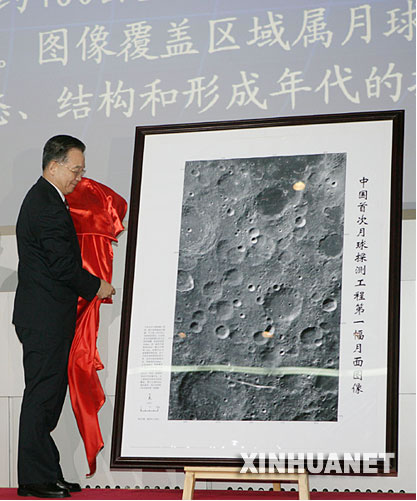
It marked a great success that the first picture of the moon surface was published officially, and the CCD stereo camera was designed by our institute.
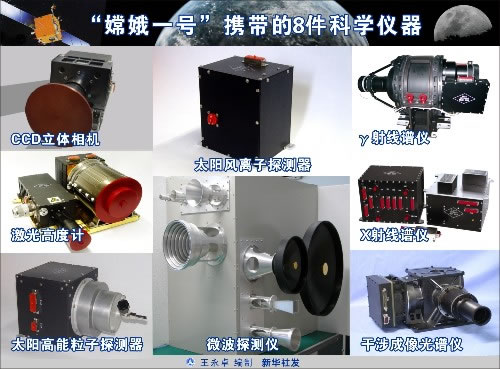
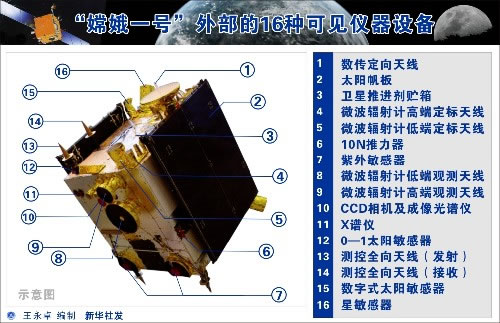
CCD camera used the method of linear array pushbroom to capture images, and per pixel resolution was 120 m. China's first lunar surface picture was located at longitude 83 to 57 degrees east, latitude 70 to 54 degrees south. The mosaic image's width is 280 km and height is 460 km. The area pictured is part of the moon's highland and on the surface there are craters of different sizes, shapes, structures and ages.
The quality of the first lunar surface picture was excellent that absolutely accorded with the design specification and indicated both the camera shooting and data processing were great success, an expert pointed out.


The Director-General of our institute ZHAO Wei and some representatives of the research group (researcher ZHAO Bao-chang, YANG Jian-feng and GAO Wei) were invited to attend the ceremony and received by Premier WEN Jia-bao.
China’s First Lunar Picture Made Public
On November 12, China’s first full-moon picture produced from lunar topography and physiognomy data taken by Chang’e 1 Lunar Satellite was officially released by State Administrating of Science, Technology and Industry for National Defense (SASTIND) and at the same releasing ceremony series of data and real items in connection with Chang’e Project were donated to National Museum for permanent collection.
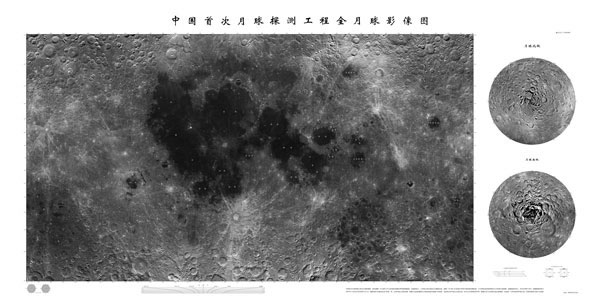
On November 26, 2007, China’s first moon picture taken by CCD camera developed by XIOPM and loaded to Chang’e 1 Lunar Satellite was officially released to the world. Afterwards, China released pictures of the lunar polar regions taken by the same CCD camera on January 31, 2008. Up to May 12, 2008, the camera took all the required pictures covering lunar regions between 70 degrees north latitude and 70 degrees south latitude. The pictures not only won examination and received positive comments from relative experts who believed that “the image data are integrative, the information is complete, signal-to-noise is high, the quality is good and the image quality and video production lives up to the international standards”. Due to CCD camera’s stable conditions, the general command of Chang’e Lunar Orbit Project decided to continue the efforts to take pictures about the polar regions of the moon, and completely got the desired image data. Then the command made polar images as a complement to make the satellite obtain full-moon images within its lifespan.
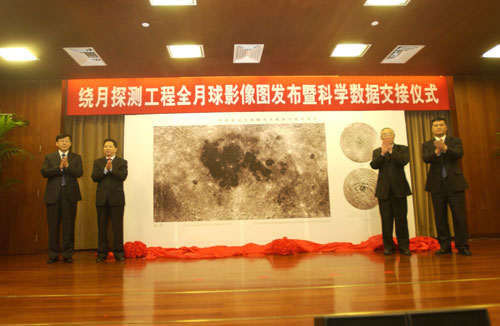
At present, Oyang Ziyuan, chief scientist of China’s Lunar Orbit Project said when he talked about how to take lunar images, “the way CCD camera of Change’e 1 Lunar Satellite takes pictures is greatly different from what people normally do. Every orbit picture taken by the satellite looks like a belt and is equivalent to 60 km of the moon surface. Every circle the satellite flies around the moon equals to one orbit which is about 10,900 km and takes about 127 minutes. One-orbit image means that the satellite-carried CCD camera uses its own lens to obtain three continuous front-view, face-view and backsight 2-dimensional images by applying three-line pushbroom imaging. In another word, the target region is taken from above and two flanks so as to get 3-dimensional pictures. The first full-moon picture is attained after the radiative, geometrical and luminous revisions and making mosaic to the 589-orbit image data taken by Satellite-carried CCD camera. The picture stretches from 180 degrees west longitude to 180 east longitude and 90 degrees north latitude and 90 south latitude.
It is known that China’s first full-moon picture is not only very clear and rich in layers, but also is the most complete one released all over the world.
Chang’e 1 Satellite Descended Orbit and CCD Camera Again Shot the Boot
According to information released by Bureau of Science and Industry for National Defense, Chang’e 1 Satellite was launched on October 24, 2007 and by October 24, 2008, the Satellite had achieved required life span indicators and successfully fulfilled all orbiting exploration tasks. Given the fact that the Satellite still functions well and has adequate fuel, after careful consideration, the decision has been made to make full use of its potential and make due in-orbit experiments to pave the way for further lunar missions.
On December 6, 2008, the Satellite descended its previous orbit as far as 200 km from the moon which had been kept for more than one year to the orbit as far as 100 km from the moon and functioned well for 13 days. During the interval, the CCD camera developed by XIOPM for Chang’e 1 Satellite again shot the boot and got the lunar picture with altitude of 100 km and resolution of 65 m (the former altitude is 200 km and resolution 120 m).
Commencing from 2 o’clock, December 19, the satellite again made orbit change and descended it to 17 km from the moon. Due to influence by lunar gravitation field, by 12 o’clock, the satellite perilune was drifted to 15 km from the moon. Up to 8 am, December 20, after the relative experiments were finished, the satellite again made orbit change and successfully returned to the circular polar orbit of 100 km from the moon.
It’s reported that the satellite will adjust orbit obliquity in due time to make lunar gravitation and orbit tests during which the payload will shoot the boot to accumulate relative data.
Real-time clear images of Chang’e I Satellite’s successful hitting moon by CCD camera
16:13:10, March 1, 2009, China’s Chang’e I hit the moon successfully under precision control of scientific and technical personnel with Beijing Aerospace Control Center and landed at the scheduled point of impact 52.36°E, 1.50°S, achieving expected goal and marking an perfect end of China’s moon exploration project Phase I. During the hitting, our institute-developed CCD three-dimensional camera real-time transmitted back the clear images of the process at the last moment to complete its historic mission.
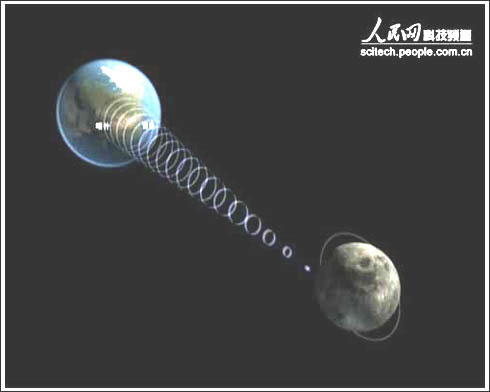

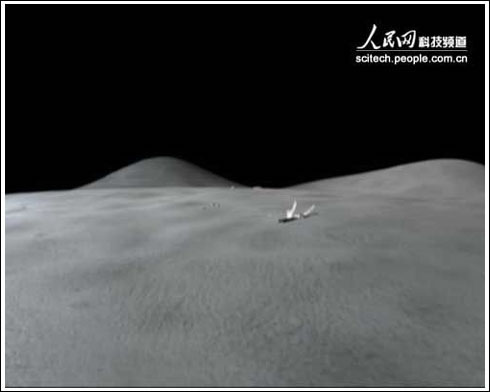
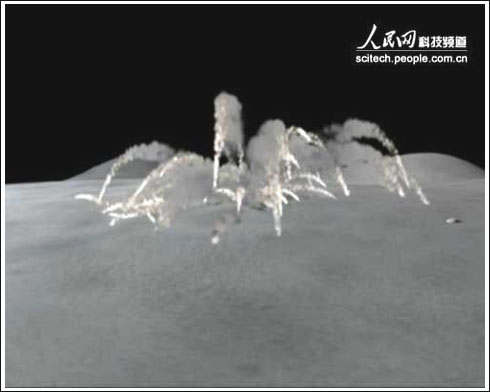
Three-dimensional model for Chang’e I Satellite’s hitting the moon


